Last year the price per share of stock X increased by k% and the earnings per share of stock X increased by m%,where>m.
By what percent did the ratio of price per share to earnings per share increase,in terms of k and m?
Ans-100(k-m)%/100+m
Searching for a shortest solution to approach such problems.
OG#177
This topic has expert replies
-
tapanmittal
- Senior | Next Rank: 100 Posts
- Posts: 31
- Joined: Fri Apr 10, 2015 4:04 am
-
theCEO
- Master | Next Rank: 500 Posts
- Posts: 363
- Joined: Sun Oct 17, 2010 3:24 pm
- Thanked: 115 times
- Followed by:3 members
Shortest way is to substitute values for all the unknowns.tapanmittal wrote:Last year the price per share of stock X increased by k% and the earnings per share of stock X increased by m%,where>m.
By what percent did the ratio of price per share to earnings per share increase,in terms of k and m?
Ans-100(k-m)%/100+m
Searching for a shortest solution to approach such problems.
original price/per share = 10
original earnings/per share = 10
k = 10 and m = 5
new price/per share = 10 + 10%(10) = 11
new earnings/per share = 10 + 5%(10)=10.5
Original ratio = 10/10 = 1
new ratio = 11/10.5
% increase = 100*(new ratio - old ratio)/ old ratio
% increase = 100*(11/10.5 -1)/10.5
% increase = 100*(11/10.5 - 10.5/10.5)/10.5
% increase = 100*(0.5)/10.5 = 50/10.5
Substitute k = 10 and m = 5 into the answer choices and see which answer gives 50/10.5
100(k-m)%/100+m
100(10-5)/100+5
500/105
500/105 = 50/10.5
GMAT/MBA Expert
- [email protected]
- Elite Legendary Member
- Posts: 10392
- Joined: Sun Jun 23, 2013 6:38 pm
- Location: Palo Alto, CA
- Thanked: 2867 times
- Followed by:511 members
- GMAT Score:800
Hi tapanmittal,
When posting questions, you should include the 5 answer choices. In many prompts, the answers provide 'clues' as to how you might choose to approach the prompt. Since most GMAT questions can be approached in a variety of ways, knowing more than just the 'math approach' will help you to attack prompts in the fastest/easiest fashion and avoid the types of pacing issues that impact many Test Takers.
GMAT assassins aren't born, they're made,
Rich
When posting questions, you should include the 5 answer choices. In many prompts, the answers provide 'clues' as to how you might choose to approach the prompt. Since most GMAT questions can be approached in a variety of ways, knowing more than just the 'math approach' will help you to attack prompts in the fastest/easiest fashion and avoid the types of pacing issues that impact many Test Takers.
GMAT assassins aren't born, they're made,
Rich
-
nikhilgmat31
- Legendary Member
- Posts: 518
- Joined: Tue May 12, 2015 8:25 pm
- Thanked: 10 times
Well plugging values may be wrong by any minor mistake.
P (1+k/100)P
E (1+m/100)E
new ratio = (100+k)P/(100+m)E
old ratio = P/E
keep P/E as A
% change = ((100+K)A/100+m) - A ) /A *100
Cancelling A as common
(100+k -100-m )*100/(100 +m)
(k-m)100/(100+m)
Done
P (1+k/100)P
E (1+m/100)E
new ratio = (100+k)P/(100+m)E
old ratio = P/E
keep P/E as A
% change = ((100+K)A/100+m) - A ) /A *100
Cancelling A as common
(100+k -100-m )*100/(100 +m)
(k-m)100/(100+m)
Done
GMAT/MBA Expert
- Scott@TargetTestPrep
- GMAT Instructor
- Posts: 7262
- Joined: Sat Apr 25, 2015 10:56 am
- Location: Los Angeles, CA
- Thanked: 43 times
- Followed by:29 members
tapanmittal wrote:Last year the price per share of stock X increased by k% and the earnings per share of stock X increased by m%,where>m.
By what percent did the ratio of price per share to earnings per share increase,in terms of k and m?
Ans-100(k-m)%/100+m
Searching for a shortest solution to approach such problems.
177) Last year the price per share of Stock X increased by k percent and the earnings per share of Stock X increased by m percent, where k is greater than m. By what percent did the ratio of price per share to earnings per share increase, in terms of k and m?
A. k/m %
B. (k - m) %
C. [100(k - m)] / (100 + k) %
D. [100(k - m)] / (100 + m) %
E. [100(k - m)] / (100 + k + m) %
Solution:
To start, we need to define a few variables.
p = price per share of stock X
e = earnings per share of stock X
We are given that the price per share of stock X increased by k percent. We can express this as:
p(1 + k/100) = p((100 + k)/100)
We are also given that the earnings per share of stock X increased by m percent. We can express this as:
e(1 + m/100) = e((100 + m)/100)
Finally, we are asked by what percent the ratio of the price per share to earnings per share increased. We'll set up our two ratios and then plug those into the percent change formula. While the math that is produced here may seem a bit complicated, it is not too bad as long as we take our time and stay focused.
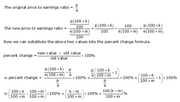
Answer:D
Scott Woodbury-Stewart
Founder and CEO
[email protected]

See why Target Test Prep is rated 5 out of 5 stars on BEAT the GMAT. Read our reviews


- Jim@StratusPrep
- MBA Admissions Consultant
- Posts: 2279
- Joined: Fri Nov 11, 2011 7:51 am
- Location: New York
- Thanked: 660 times
- Followed by:266 members
- GMAT Score:770
Uh.... I would stay away from the algebra. It's too easy to make a mistake. Have a look at this...
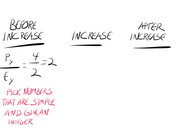
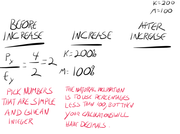
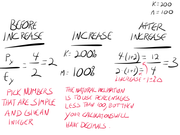
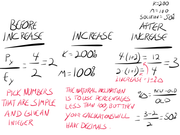
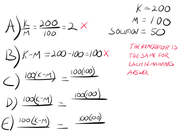
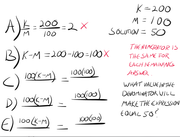
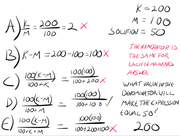
[/img]







[/img]
GMAT Answers provides a world class adaptive learning platform.
-- Push button course navigation to simplify planning
-- Daily assignments to fit your exam timeline
-- Organized review that is tailored based on your abiility
-- 1,000s of unique GMAT questions
-- 100s of handwritten 'digital flip books' for OG questions
-- 100% Free Trial and less than $20 per month after.
-- Free GMAT Quantitative Review

-- Push button course navigation to simplify planning
-- Daily assignments to fit your exam timeline
-- Organized review that is tailored based on your abiility
-- 1,000s of unique GMAT questions
-- 100s of handwritten 'digital flip books' for OG questions
-- 100% Free Trial and less than $20 per month after.
-- Free GMAT Quantitative Review

- GMATGuruNY
- GMAT Instructor
- Posts: 15539
- Joined: Tue May 25, 2010 12:04 pm
- Location: New York, NY
- Thanked: 13060 times
- Followed by:1906 members
- GMAT Score:790
Original ratio:Last year the price per share of Stock X increased by k percent and the earnings per share of Stock X increased by m percent, where k is greater than m. By what percent did the ratio of price per share to earnings per share increase, in terms of k and m?
A) k/m%
B) (k-m)%
C) 100(k-m)/100+k %
D) 100(k-m)/100+m %
E) 100(k-m)/100+k+m %
Let the original price = 100 and the original earnings = 100.
Resulting ratio:
price/earnings = 100/100 = 1.
New ratio:
Let k=200 and m=100.
Since the price increases by k=200%, the new price = 100 + (200/100)(100) = 300.
Since the earnings increase by m=100%, the new earnings = 100 + (100/100) = 200.
Resulting ratio:
(new price)/(new earnings) = 300/200 = 1.5.
Since the old ratio = 1 and the new ratio = 1.5, the ratio increases by 50%. This is our target.
Now plug k=200 and m=100 into the answers to see which yields our target of 50.
Only D works:
100(k-m)/(100+m) = (100)(200-100) / (100+100) = 50.
The correct answer is D.
Private tutor exclusively for the GMAT and GRE, with over 20 years of experience.
Followed here and elsewhere by over 1900 test-takers.
I have worked with students based in the US, Australia, Taiwan, China, Tajikistan, Kuwait, Saudi Arabia -- a long list of countries.
My students have been admitted to HBS, CBS, Tuck, Yale, Stern, Fuqua -- a long list of top programs.
As a tutor, I don't simply teach you how I would approach problems.
I unlock the best way for YOU to solve problems.
For more information, please email me (Mitch Hunt) at [email protected].
Student Review #1
Student Review #2
Student Review #3
Followed here and elsewhere by over 1900 test-takers.
I have worked with students based in the US, Australia, Taiwan, China, Tajikistan, Kuwait, Saudi Arabia -- a long list of countries.
My students have been admitted to HBS, CBS, Tuck, Yale, Stern, Fuqua -- a long list of top programs.
As a tutor, I don't simply teach you how I would approach problems.
I unlock the best way for YOU to solve problems.
For more information, please email me (Mitch Hunt) at [email protected].
Student Review #1
Student Review #2
Student Review #3
GMAT/MBA Expert
- Brent@GMATPrepNow
- GMAT Instructor
- Posts: 16207
- Joined: Mon Dec 08, 2008 6:26 pm
- Location: Vancouver, BC
- Thanked: 5254 times
- Followed by:1268 members
- GMAT Score:770
Another approach is to plug in values.Last year the price per share of Stock X increased by k percent and the earnings per share of Stock X increased by m percent, where k is greater than m. By what percent did the ratio of price per share to earnings per share increase, in terms of k and m?
A) k/m%
B) (k-m)%
C) 100(k-m)/100+k %
D) 100(k-m)/100+m %
E) 100(k-m)/100+k+m %
Let $100 be the original price per share of Stock X
Choose a "nice" value for k. How about k = 200
So, after a 200% increase, the new price per share = $300
Let $100 be the original earnings per share of Stock X
Choose a "nice" value for m. How about m = 100
So, after a 100% increase, the new earnings per share = $200
Original ratio of price/earnings = $100/$100 = 1
New ratio of price/earnings = $300/$200 = 1.5
By what percent did the ratio of price per share to earnings per share increase?
So, the percent increase (from 1 to 1.5) is 50%.
In other words, when k = 200 and m = 100, the ratio increases 50%
Now, plug in 200 for k, and 100 for m, and look for the answer choice that also yields 50%.
A. k/m = 200/100 = 2 (nope)
B. (k - m) = 200 - 100 = 100 (nope)
C. [100(k - m)] / (100 + k) = 10,000/300 = 33.333 (nope)
D. [100(k - m)] / (100 + m) = 10,000/200 = 50 GREAT!
E. [100(k - m)] / (100 + k + m) = 10,000/400 = 25 (nope)
Answer: D
Cheers,
Brent





















